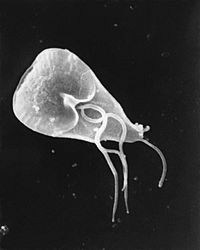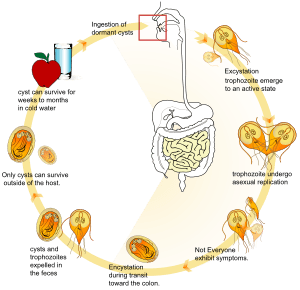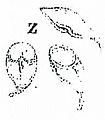Giardia lamblia facts for kids
Quick facts for kids Giardia lamblia |
|
|---|---|
 |
|
| Giardia cell, SEM | |
| Scientific classification | |
| Domain: | |
| Phylum: |
Metamonada
|
| Order: |
Diplomonadida
|
| Family: |
Hexamitidae
|
| Binomial name | |
| Giardia lamblia |
|
Giardia lamblia (also known as Lamblia intestinalis and Giardia duodenalis) is a tiny parasite. It is a very small living thing that lives inside another living thing, like you or an animal. This parasite infects the intestines and causes a sickness called giardiasis or 'beaver fever'. Giardia affects humans, cats, dogs, birds, cows, beavers, deer, and sheep.
Contents
What is Giardia?
Giardia lamblia is a type of protozoa. Protozoa are single-celled organisms, meaning they are made of just one cell. These tiny creatures are too small to see without a microscope. Giardia can live in the intestines of many animals and people. It can cause problems with digestion and make you feel sick.
How Do You Get Giardiasis?
Giardiasis spreads when someone accidentally swallows Giardia germs. These germs are found in the poop of infected people or animals. You can get infected in several ways:
- Drinking contaminated water: This is the most common way. Water in lakes, rivers, or even swimming pools can have Giardia if it's not treated properly.
- Eating contaminated food: Sometimes, food can get Giardia germs on it if it's handled by someone who is infected and hasn't washed their hands.
- Contact with infected people or animals: If you touch surfaces or objects that have poop from an infected person or animal, and then touch your mouth, you can get sick. This is why handwashing is so important.
What Are the Symptoms of Giardiasis?
If you get giardiasis, you might start to feel sick about one to three weeks after being infected. The symptoms can last for several weeks. Common symptoms include:
- Diarrhea, which can be watery or greasy.
- Stomach cramps or pain.
- Feeling bloated.
- Nausea (feeling sick to your stomach).
- Weight loss.
- Sometimes, you might not have any symptoms at all, but you can still spread the parasite to others.
Life Cycle of Giardia
Giardia has a simple life cycle with two main forms:
Cysts
The first form is called a cyst. Cysts are like tiny, tough shells that protect the Giardia parasite. They are found in the poop of infected people or animals. Cysts can survive for a long time outside the body, especially in cold water. This is how the parasite spreads to new hosts. When you swallow a cyst, it travels to your intestines.
Trophozoites
Once the cyst reaches your small intestine, it opens up. Inside, the Giardia parasite comes out in its active form, called a trophozoite. Trophozoites are pear-shaped and have whip-like tails called flagella. They use these flagella to move around and attach to the lining of your intestine. They feed and multiply there. When they are ready to leave the body, they turn back into cysts and are passed out in poop, starting the cycle again.
How to Prevent Giardiasis
Preventing giardiasis is mostly about good hygiene and being careful about what you eat and drink. Here are some tips:
- Wash your hands often: Always wash your hands with soap and water, especially after using the bathroom, changing diapers, and before eating or preparing food.
- Drink safe water: If you are camping or in an area where water quality is uncertain, boil your water or use a water filter that removes parasites. Avoid swallowing water from lakes, rivers, or untreated swimming pools.
- Be careful with food: Wash fruits and vegetables thoroughly, especially if you plan to eat them raw.
- Avoid contact with animal poop: If you have pets, make sure to clean up their waste properly.
Images for kids
-
Multiple views of a G. lamblia cyst imaged by confocal microscopy: Bar = 10 micrometers (A) Cyst imaged by transmission (differential interference contrast) (B) Cyst wall selectively imaged through use of fluorescent-labelled antibody (C) Cyst imaged through use of carboxy fluorescein diacetate, a viability stain (D) Composite image of (B) and (C) (E) Composite image of (A), (B), and (C)
See also
 In Spanish: Giardia lamblia para niños
In Spanish: Giardia lamblia para niños





